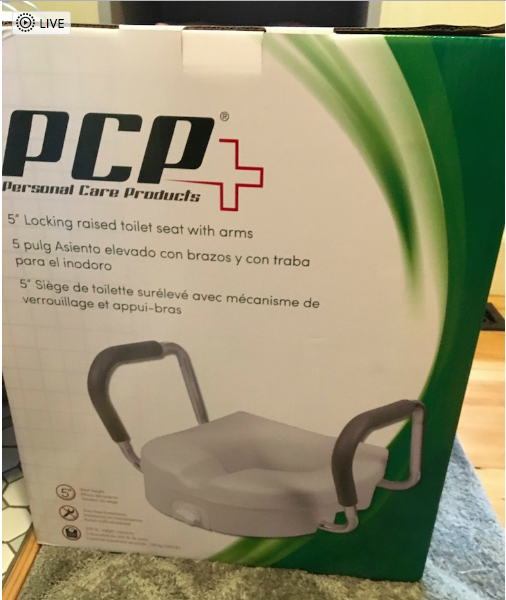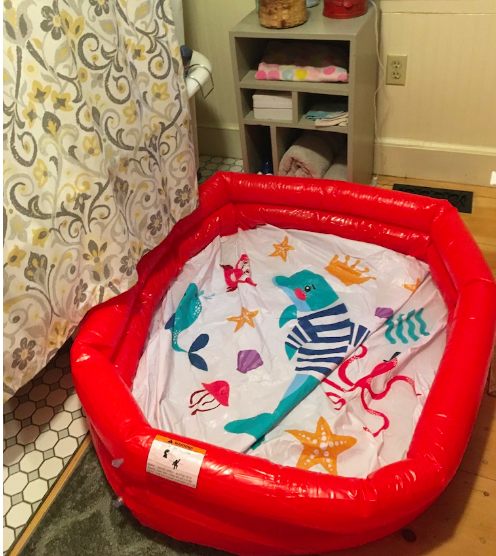Caring for a total knee replacement patient
(This post may contain affiliate links. See the full affiliate disclosure here for more info.)
Before my husband had a knee replacement, he had consultations with different surgeons, asked advice from other patients, read all he could, and watched some YouTube videos about recovery.
But none of those resources fully explained what would be expected of me as his caregiver, especially in the first 2 to 4 weeks. We did some preparation, mostly by having other former patients ask us things like “You did buy a cooling water pump, right?”
So, I compiled this retrospective list of advice based on my experience. Yes, every patient is different, and every patient’s recovery will be different. It’s even different depending upon whether the patient is right or left-handed and which leg will be operated on (it makes a difference in being able to thoroughly cleanse after toileting, believe it or not). Thus, every caregiver’s experience will be different.
Advice for the caregiver of a knee replacement patient:
In advance, stock up on:
- Ice cubes
- Food or, optimally, meals in the freezer
- Any other household items you might need
- All large, heavy things like 50 lb bags of dog food, chicken food, and cat food and kitty litter
Be prepared to:
- Take over all daily chores: shopping, meal prep, bill-paying, dishes, laundry, lawn care, pet and animal care
- Not be able to leave the patient alone to run to the store or pharmacy for 1 or 2 weeks
- Help the patient 24/7 with transfer, pills, meals, bathing, toileting, clothes changes, fetching items needed (cell phone, remote)
Do these tasks ahead of time:
- Get your haircut and the patient’s
- Make and go to any doctor and dentists appointments you can before surgery
- Wash all bedding the night before surgery
- Clean the bedroom at the least, but the whole house is better. I did a thorough combined spring-summer-fall cleaning
- If you have time, do any larger household or work projects you can do. You will be less stressed in a clean, orderly house (or at least I was)
- Mow lawn as close to surgery as possible
- Wash the dog and clip his/her nails
- Have patient strengthen their quads (see timeline below)
Acquire:


- Additional ice cube trays
- Cool water circulating pump. I go mine on Amazon.
- Recliner
- Pillows of different sizes and shapes
- Toilet seat riser. I got mine on Amazon
- Walker with wheels
- 2 canes, at least one with a hook
- Heating pad
- Urinal
- Paper plates
- Baggy shorts and tee shirts
- Trauma cream. My husband likes Traumeel but it’s pricey.
- Gatorade and bananas for muscle spasms
- Tylenol (coated) and maybe Tylenol PM
- Laxatives like Colase and Miralax
- Fruit
- High-fiber cereal
- A car or truck with ample leg room for the ride home from the hospital
- Tray for serving food
- Shower or tub chair
Helpful tips
Take at least 2 weeks off. Find someone to come in during the day periodically for the following 2 weeks. Thankfully, I work from home as a proofreader, so only took one week off and could be here 24/7.
I saw a YouTube video that said people with a desk job might be able to go back to work 2-3 weeks after surgery. I would not count on that. I think 6-12 weeks is more realistic and even then, it might not be possible. Knees get stiff if held in one position for hours in a row.
Other general timelines
I did my best to estimate when my husband could perform certain tasks or had certain mobilities. Some of these came up gradually, so the timeline is really a range. And these are GENERAL ranges that will vary with the patient. But, as a caregiver, looking forward to these can be the light at the end of the tunnel.
These are approximately when my husband could/was:
- Horizontally lift his surgical leg ~ 1-2 weeks
- Walk for a bit without intense pain ~ 3 weeks
- Off regular pain meds (using them only for breakthrough pain) ~ 3 ½ weeks
- Drive an automatic transmission/riding lawn mower ~ 5 weeks (but the patient needs to be off prescription pain meds)
- Walk for more than the distance between the chair and bed or toilet ~3 ½ weeks
- Walk with a cane ~ 3 ½ weeks
- Walk without a cane ~ 5 weeks (but still use a cane for distances or uneven ground)
- In-home PT for 2 weeks, then at a local PT clinic twice a week
- Started once weekly at 8 weeks and also did one therapeutic session at our local pool
Other caregiver roles
The patient will/might need help with these:
- Don’t be surprised if the patient has no bowel movement for a week. Try to provide high fiber food and stool softener and LOTS of WATER.
- Getting into and out of a chair by supporting the surgical leg for at least 2 weeks.
- Getting dressed. It will be difficult for the patient to support their full weight on the surgical leg for about 3 weeks.
- Climb more than several stairs – more than 2 weeks
- Climb into a clawfoot tub – about 4 weeks
- At about 3 ½ weeks, the intense pain should have subsided, and mobility should have improved. The patient may not be able to bend the knee fully yet but may change from using a walker to a cane.
- Keeping track of the medication schedule. The patient will be sent home with a med schedule, but you have to juggle pain relief.
- If the patient is on warfarin, he/she cannot have ibuprofen (Advil), and acetaminophen (Tylenol) is only recommended at 1000 mg every 6 hours. That means that if it is given at 9 am, it can’t be given again until 3 pm, then 9 pm. If the patient is in a fair amount of pain, be sure to fit in the 3pm dose.
- Our doctor said that the 9pm dose could be Tylenol pm, which contains diphenhydramine. It helped him relax and sleep better.
- Prescription pain meds were given as directed and were pretty much needed the first 3 weeks. Then, things got better and by 6 weeks, he was taking Tylenol in the AM and Tylenol pm at bedtime.
- Now, at 9 weeks, he is only taking Tylenol at bedtime.
Special bedtime needs
Bedtime presents special challenges. Night is often a more painful time for people with medical problems. And, since it’s often older people who have knee surgery, and those people usually get up at night to use the bathroom, and since the patient will be uncomfortable in most positions in bed, you will have to be extra-patient, extra-attentive, and extra-helpful.
The patient will need help:
- Elevating the leg higher than the heart to keep swelling down in the first two weeks. Even if this isn’t what your patient needs, it will be painful for the knee to be bend when lying down and pillows will need to be strategically placed under the knee. The visiting physical therapist will show you how to do this.
- Getting up the water pump, initially, and the ice wrap, later, ready and applied for sleeping
- Getting bedtime meds ready
- Setting up a cup of water and a urinal for night-time use
The patient may want to use the bathroom for toileting at night. This means that you will have to provide assistance getting out of bed, to the walker, and to the toilet each time. Then, you will have to resettle the patient back in bed.
The patient may prefer to sleep in a recliner for the first 2 weeks. That means that you need to be within earshot to help with toileting.
My husband had severe leg spasms in the upper thigh of the surgical leg the first week or so. Sugar-free Gatorade and bananas daily helped to prevent them. Once they start, a heating pad or heated bean or rice bag can help ease them. Have them where you can access them fast if this type of pain hits.
Bathing
Our walk-in shower is up 10 stairs so that was out of the question for a while. The downstairs tub is a clawfoot tub and my husband couldn’t swing or bed his knee that high for a while, so I got creative.

I bought a kid’s blow-up pool and stuck it slightly under the tub between the legs. I spread towels around and had my husband stand in the tub supported by his walker. I used the handheld sprayer from the tub to hose him down, then lathered him up and hosed him down again. It worked fine, he felt much better and the bathroom floor got a little cleaning.
A typical day for me caring for my husband after knee replacement surgery
For the first 2-3 weeks:
7am-noon
- Wake up and help husband to toilet with walker
- Empty urinal if he slept on the recliner or didn’t want to get up at night
- Help him to recliner
- Bring him a cup of water, some saltines so the meds wouldn’t be taken on an empty stomach and his meds
- Set up cold pump with fresh ice or get new ice packs for the wrap. Apply to patient.
- Walk dog
- Feed dog and cat
- Make coffee
- Make him breakfast, which was cereal and a banana for the muscle spasms, and coffee.
- Make bed (the PT used the bed for therapy twice a week)
- Feed chickens and let them out
- Put away yesterday’s dishes and take care of breakfast dishes
- Take meat out of the freezer for dinner
- Help husband to toilet as needed
- Bring a snack of nuts or fruit and Gatorade mid-morning
- Edit for 3 hours
- Take to or prepare for PT appointment
Noon – afternoon
- Make lunch
- Take care of lunch dishes
- Edit 3 more hours
- Do laundry and other chores
- Every 2-3 days, help husband with sponge bath or bathing
5PM
- Start dinner
- Let chickens into coop, collect eggs, and hose outer chicken pen (because we have ducks. Enough said)
- Run articles through Grammarly
- Walk dog
- Feed dog
6PM
- Eat dinner. Serve husband in recliner for 2 weeks or so.
- Clean up after dinner. Do dishes
- Re-read articles I edited and submit them
9PM-10PM
- Walk dog
- Help husband get settled in bed or recliner, including meds and setting up cold wrap or water pump.
Neither of you should get discouraged!
Once you get through the first 2-3 weeks, things get better for both of you. Pain decreases and mobility increases every week.
We had relatives visit for the weekend 4 weeks after surgery. True, we didn’t invite all the family to join us like we usually do when out-of-state relatives visit, but he was able to enjoy the visit.
I cooked a turkey and made summer salads as sides (see my favorite summer salads here) and we had leftover turkey in enchiladas and Mexican corn salad the next day. It cut down on my food prep time and left more time to enjoy the visit.
By 5-6 weeks, my husband:
- Was going stir-crazy
- Was driving himself the 1.25 miles to PT
- Doing dishes occasionally
- Mowing the (large) lawn on a riding mower
- Taking longer walks
- Making dinner once in a while
- It was still difficult to stand unsupported for very long, which made doing dishes and meal prep challenging
- Getting his evening meds and setting up pillows for under his leg and/or ice wrap for bedtime use
- Was walking the dog once a day
By 7-8 weeks, my husband:
- Was starting swimming for one of his weekly PT sessions
- Helped paint some of the exterior of the house that he could do without climbing a ladder
- Cooking more
- Taking longer walks with the dog
- Went into stores with me, knowing the cart could help support him
- Doing more dishes
- Was up and about for most of the day instead of in a chair with his leg elevated
- Attended a grandkid’s birthday party
Now, at 9 weeks, he’s in the kitchen making dinner and has just walked the dog. I still assume that I need to do it all (just in case) and I consider it my job to remind him to bend his leg when he walks, not overdo it, and make sure he keeps every physical therapy appointment.
Some people think physical therapy isn’t worth it and judge the whole process by the first visit. but it is progressive therapy that changes with each visit as the patient improves. They will push him or her to do more, help reinforce what are reasonable expectations, and provide necessary and realistic encouragement.
Don’t despair! Stay organized and stay positive. Give the patient 12 weeks and await the better-than-before version!








